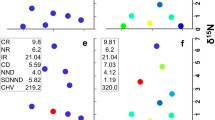Abstract
Terminal restriction fragment length polymorphism (T-RFLP) is increasingly being used to examine microbial community structure and accordingly, a range of approaches have been used to analyze data sets. A number of published reports have included data and results that were statistically flawed or lacked rigorous statistical testing. A range of simple, yet powerful techniques are available to examine community data, however their use is seldom, if ever, discussed in microbial literature. We describe an approach that overcomes some of the problems associated with analyzing community datasets and offer an approach that makes data interpretation simple and effective. The Bray-Curtis coefficient is suggested as an ideal coefficient to be used for the construction of similarity matrices. Its strengths include its ability to deal with data sets containing multiple blocks of zeros in a meaningful manner. Non-metric multi-dimensional scaling is described as a powerful, yet easily interpreted method to examine community patterns based on T-RFLP data. Importantly, we describe the use of significance testing of data sets to allow quantitative assessment of similarity, removing subjectivity in comparing complex data sets. Finally, we introduce a quantitative measure of sample dispersion and suggest its usefulness in describing site heterogeneity.
Similar content being viewed by others
References
Avaniss-Aghajani E., Jones K. and Chapman B.C. 1994. Amolecular technique for identification of bacteria using smallsubunit ribosomal RNA sequences. BioTechniques 17: 143–149.
Bray J.R. and Curtis J.T. 1957. An ordination of the upland forestcommunities of southern Wisconsin. Ecol. Monographs 27: 325–349.
Clarke K.R. 1993. Non-parametric multivariate analysis of changesin community structure. Aust. J. Ecol. 18: 117–143.
Clarke K.R. and Warwick R.M. 2001. Change in marine commu-nities:an approach to statistical analysis and interpretation, 2nd edition. PRIMER-E, Plymouth, UK.
Clement B.G., Kehl L.E., DeBord K.L. and Kitts C.L. 1998. Ter-minalrestriction fragment patterns (TRFPs), a rapid, PCR-basedmethod for the comparison of complex bacterial communities. J. Microbiol. Meth. 31: 135–142.
Díez B., Pedrós-Alió C., Marsh T.L. and Massana R. 2001. Appli-cationof denaturing gradient gel electrophoresis (DGGE( tostudy the diversity of marine picoeukaryotic assemblages andcomparison of DGGE with other molecular techniques. Appl. Environ. Microbiol. 67: 2942–2951.
Dollhopf S.L., Hashsham S.A. and Tiedje J.M. 2001. Interpreting16S rDNA T-RFLP data: applications of self-organizing mapsand principal component analysis to describe communitydynamics and convergence. Microb. Ecol. 42: 495–505.
Eichner C., Erb R.W., Timmis K.T. and Wagner-Döbler I. 1999. Thermal gradient gel electrophoresis analysis of bioprotectionfrom pollutant shocks in the activated sludge microbial commu-nity. Appl. Environ. Microbiol. 65: 102–109.
Faith D.P., Humphrey C.L. and Dostine P.L. 1991. Statistical powerand BACI designs in biological monitoring: comparative evalu-ationof measures of community dissimilarity based on benthicmacroinvertebrate communities in Rockhole Mine Creek,Northern Territory, Australia. Aust. J. Mar. Freshwat. Res. 42: 589–602.
Fierer N., Schimel J.P. and Holden P.A. 2003. Influence of dryingand rewetting frequency on soil bacterial community structure. Microb. Ecol. 45: 63–71.
Flynn S.J., Löffler F.E. and Tiedje J.M. 2000. Microbial commu-nitychanges associated with a shift from reductive dechlorina-tionof PCE to reductive dechlorination of cis-DCE and VC. Environ. Sci. Technol. 34: 1056–1061.
Gong J., Forster R.J., Yu H., Chambers J.R., Sabour P.M., Wheat-croftR. and Chen S. 2002. Diversity and phylogenetic analysisof bacteria in the mucosa of chicken ceca and comparison withbacteria in the cecal lumen. FEMS Microbiol. Lett. 208: 1–7.
Hiraishi A., Iwasaki M. and Shinjo H. 2000. Terminal restrictionpattern analysis of 16S rRNA genes for the characterization ofbacterial communities of activated sludge. J. Biosci. Bioeng. 90: 148–156.
Kruskal J.B. 1964. Multidimensional scaling by optimizing good-nessof fit to a nonmetric hypothesis. Psychometrika 298: 1–27.
Lambshead P.J.D. 1986. Sub-catastrophic sewage and industrialwaste contamination as revealed by marine nematode faunalanalysis. Mar. Prog. Ser 29: 247–260.
Legendre P. and Gallagher E.D. 2001. Ecologically meaningful transformations for ordination of species data. Oecologia 129: 271–280.
Legendre P. and Legendre L. 1988. Numerical Ecology. Elsevier,Amsterdam, The Netherlands.
Liu W-T., Marsh T.L., Cheng H. and Forney L.J. 1997. Charac-terizationof microbial diversity by determining terminal restric-tionfragment length polymorphisms of genes encoding 16SrRNA. Appl. Environ. Microbiol. 63: 4516–4522.
Lucklow T., Dunfield P.F. and Liesack W. 2000. Use of T-RFLPtechniques to assess spatial and temporal changes in the bacte-rialcommunity structure within an agricultural soil planted withtransgenic and non-transgenic potato plants. FEMS Microbiol. Ecol. 32: 241–247.
Lüdemann H., Arth I. and Liesack W. 2000. Spatial changes in thebacterial community structure along a vertical gradient inflooded paddy soil cores. Appl. Environ. Microbiol. 66: 754–762.
Nielsen D.L. and Chick A.J. 1997. Flood mediated changes inaquatic macrophyte community structure. Mar. Freshwat. Res. 48: 153–157.
Quinn G.P. and Keogh M.J. 2002. Experimental design and dataanalysis for biologists. Cambridge University Press, Cambridge,UK.
Sait L., Galic M., Strugnell R.A. and Janssen P.H. 2003. Secretoryantibodies do not affect the composition of the bacterial micro-biotain the terminal ileum of 10-week-old mice. Appl. Environ. Microbiol. 69: 2100–2109.
Sessitsch A., Gyamfi S., Stralis-Pavese N., Weilharter A. and Pfei-ferU. 2002. RNA isolation from soil for bacterial communityand functional analysis: evaluation of different extract and soilconservation protocols. J. Microbiol. Meth. 51: 171–179.
Shiel R.J., Green J.D. and Nielsen D.L. 1998. Floodplain biodiver-sity:Why are there so many species? Hydrobiologia. 387: 39–46.
Urakawa H., Yoshida T., Nishimura M. and Ohwada K. 2000. Characterization of depth-related population variation in micro-bialcommunities of a coastal marine sediment using 16SrDNA-based approaches and quinone profiling. Environ. Microbiol. 2: 542–554.
van Hannen E.J., Zwart G., van Agterveld M.P., Ebert J. and Laan-broekH.J.L. 1999. Changes in bacterial and eukaryotic commu-nitystructure after mass lysis of filamentous cyanobacteriaassociated with viruses. Appl. Environ. Microbiol. 65: 795–801.
Warwick R.M. and Clarke K.R. 1993. Increased variability as asymptom of stress in marine communities. J. Exp. Mar. Biol. Ecol. 172: 215–226.
Weisburg W.G., Barns S.M., Pelletier D.A. and Lane D.J. 1991. 16S ribosomal DNA amplification for phylogenetic study. J. Bacteriol. 173: 797-703.
Author information
Authors and Affiliations
Rights and permissions
About this article
Cite this article
Rees, G.N., Baldwin, D.S., Watson, G.O. et al. Ordination and significance testing of microbial community composition derived from terminal restriction fragment length polymorphisms: application of multivariate statistics. Antonie Van Leeuwenhoek 86, 339–347 (2004). https://doi.org/10.1007/s10482-004-0498-x
Issue Date:
DOI: https://doi.org/10.1007/s10482-004-0498-x




